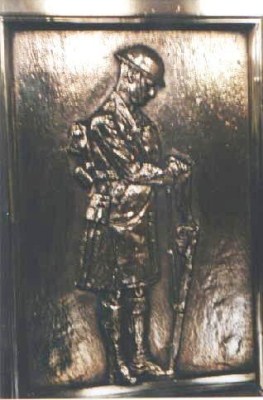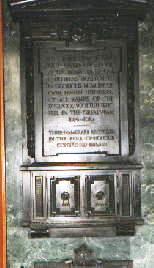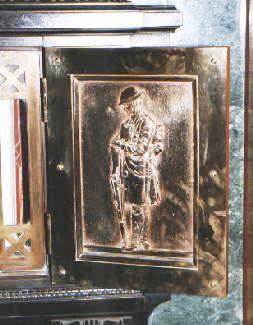WW1 Memorial
The Liverpool Scottish War Memorial
(Great War/First World War).
The memorial was relocated in St. George's Hall in the centre of Liverpool during 2010 and is situated in the original South Entrance Hall, now known as the 'Power and Glory Room'. St George's Hall is the most prestigious public building in Liverpool and is located immediately opposite Lime Street station. The Heritage Centre is normally open with free admission from 10am to 5pm on all days except Sunday and Monday and some Bank Holidays. Normally, leaflets outlining the 'Brief History of the Liverpool Scottish' are available (not to be confused with the 40-page publication, A Brief History of the Liverpool Scottish 1859-2006, by Dennis Reeves which is available from the Museum Trust Secretary). The Conservation Centre of National Museums Liverpool supervised the dismounting and movement of the memorial from its location at Botanic Road (in the previous Liverpool Scottish Museum), its refurbishment and the subsequent remounting in St George's Hall.
This memorial was originally placed in Regimental HQ at Fraser Street in the centre of Liverpool and was moved in 1967 to Forbes House, HQ of V (The Liverpool Scottish) Company, 51st. Highland Volunteers. The memorial was executed by H. Tyson Smith, a very well-known Liverpool sculptor who also executed the bronze relief panels on the cenotaph on St. George's Plateau in Liverpool. The panels on the cenotaph also show Liverpool Scottish figures together with those of other Liverpool regiments.
The two information panels presently displayed on either side of the War Memorial at St George's Hall contain the text as follows
-
This bronze war memorial of the Liverpool Scottish, then the 10th (Scottish) Battalion of the King’s (Liverpool Regiment), was unveiled on 9 June 1923 by General Lord Horne at the Drill Hall in Fraser Street, Liverpool. It contains an illuminated leather-bound book recording the names, all listed equally, of over 1,100 Territorial officers and men of the Liverpool Scottish who fell in the First World War. Designed by Major Campbell of the Regiment, it was sculpted by Liverpool’s Herbert Tyson Smith, who made the plaques on the cenotaph on St George’s Plateau. (Copyright: Liverpool City Council/Liverpool Scottish Regimental Museum Trust 2010)
-
A later plaque below the main tablet commemorates over 220 men of the Regiment, by then part of the Queen’s Own Cameron Highlanders, who died in the 1939-1945 war. The memorial was relocated to Forbes House in Childwall in 1967 and, in 2002, to the Liverpool Scottish Museum in Botanic Road. It is one aspect of the Liverpool Scottish commemoration of their dead. The others are a carved wooden tablet, originally in St. Andrew’s Church in Rodney Street, an endowed cot at the Children’s Hospital and a donation to the Scottish National War Memorial at Edinburgh Castle. The 1938 Colours of the Liverpool Scottish are laid up in Liverpool Town Hall. (Copyright: Liverpool City Council/Liverpool Scottish regimental Museum Trust 2010)
The wording on the memorial itself is
"This tablet together with an endowed cot at the Royal Liverpool Children's Hospital is in glorious memory of over eleven hundred of all ranks of The Liverpool Scottish who fell in the Great War 1914 - 1919"
and below
"Their names are recorded on the Roll of Honour herein"
Details of the doors are shown below in which a soldier fully-equipped for the front line is seen resting with 'arms reversed' (the drill position to indicate mourning with the left foot slightly advanced, the head bowed and the rifle reversed with hands resting on the butt of the weapon). Almost identical figures are found on the wooden memorial from St. Andrew's Church of Scotland.
 |
 |
 |
On the wall immediately below the Great War Memorial is a memorial plaque to the dead of the Second World War
Previous page: The Chavasse Memorial
Next page: WW2 Memorial